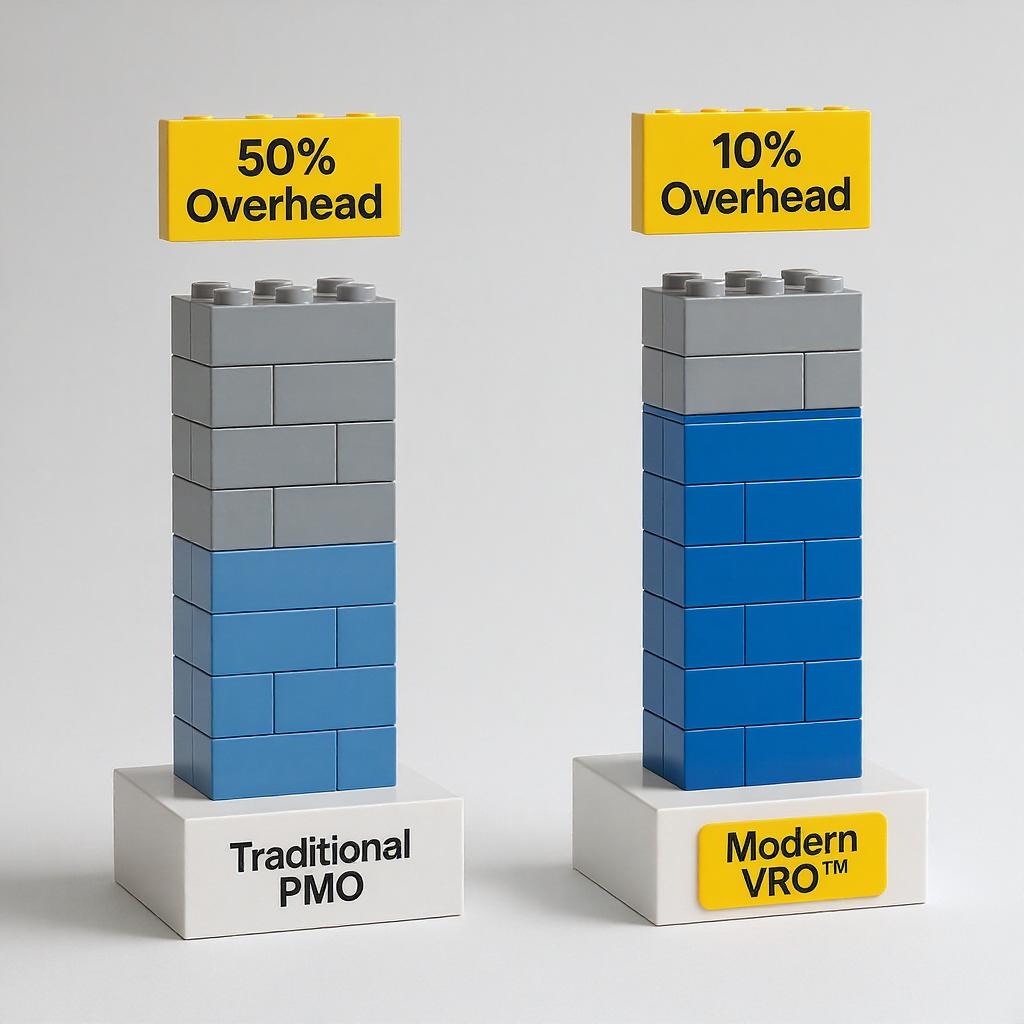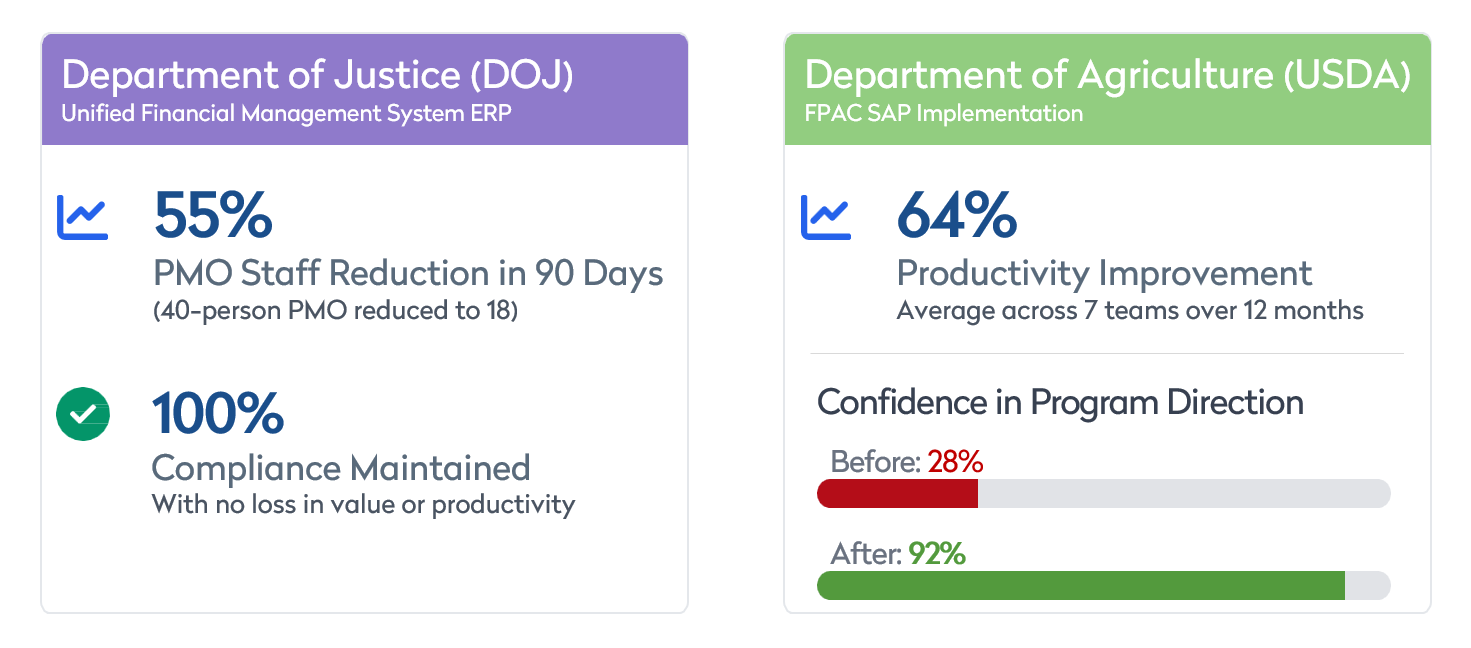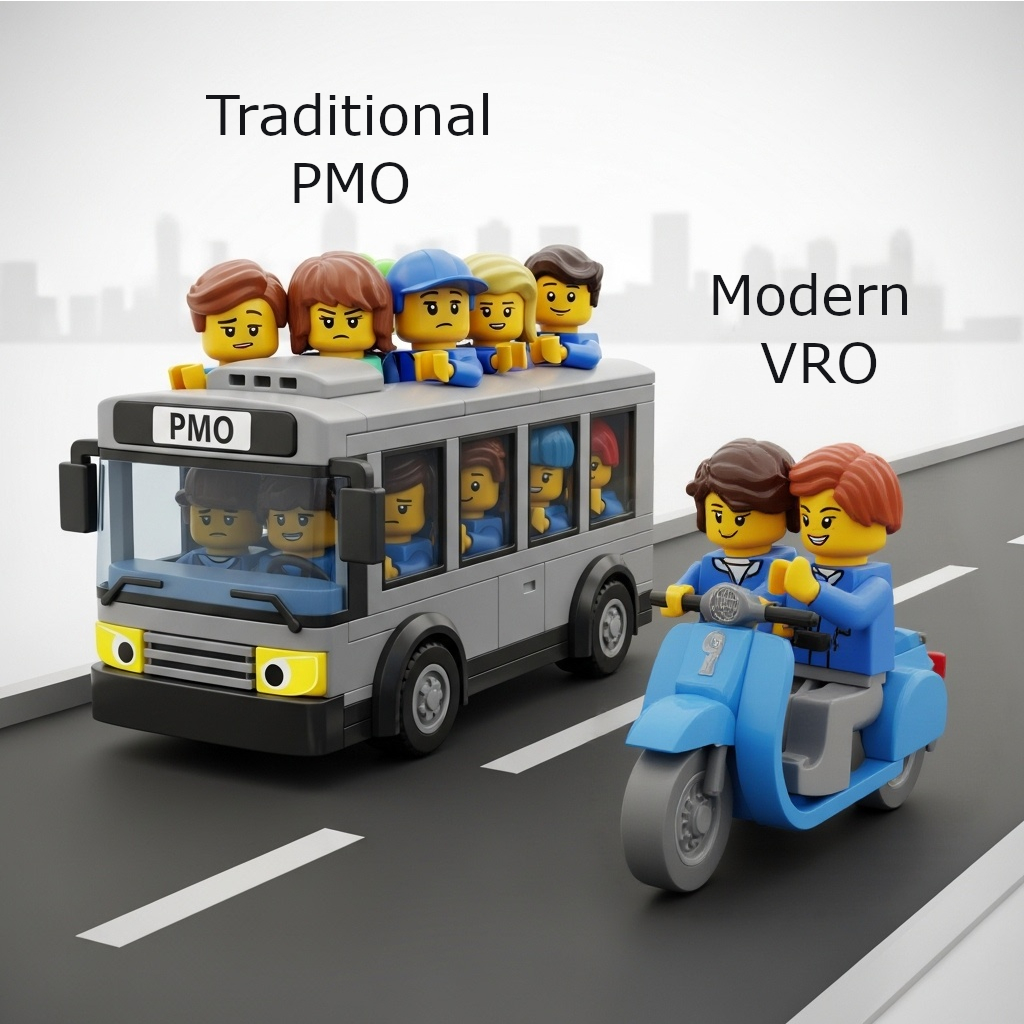💡Read This Series in Order
This is Part 1 of our smaller PMO transformation series. After reading this article, continue with Part 2: How to Shrink Your PMO — A Practical Implementation Guide for step-by-step transformation tactics.
Executive Summary
The Challenge: A major federal agency is 10 years into a multi-billion-dollar modernization program with 500 people delivering the solution — and 250 people in the Project Management Office (PMO) overseeing it. This extreme 1:2 oversight-to-delivery ratio has consistently slowed decisions, increased costs, and limited measurable results, reflecting a government-wide pattern that strangles mission delivery.
The Solution: Shrink PMOs to accelerate delivery. The counterintuitive approach: embed oversight and compliance functions directly within delivery teams while maintaining independence and accountability. This fundamental shift changes both mindset and behavior—when former oversight staff experience the friction their own processes create, they naturally eliminate bureaucracy that doesn't add delivery value.
Agencies implementing this type of transformation can achieve massive productivity improvements, reduce PMO headcount by 25–40%, and dramatically improve on-time delivery.
💡Note on Scope
We use software-centric transformation examples, but the principles apply to most federal PMOs.
Improving Delivery Within Existing Budgets
Budget constraints don't necessarily mean slower delivery; the key is redirecting effort from oversight to execution.
Congress wants more results, OMB wants smaller budgets, and everyone wants faster delivery. Meanwhile, you're dealing with the same oversight requirements, the same compliance burden, and often the same staff you had years ago.
So what do we do? How can we really do more with less? There's an important indicator most programs overlook: how many people are overseeing work versus how many are actually doing it. This ratio tells you a lot about how fast your program can move and how much it will actually deliver. We call it the non-delivery to delivery staff ratio.
Most program managers we talk to know their total headcount, their burn rate, their milestone dates. But ask them how many people are in meetings about the work versus how many are building the actual solution? They have to stop and think. We get it — nobody tracks that ratio because they don't know how important it is.
When agencies fix this ratio, they see significant results: up to 64% more productivity with significantly less overhead — with the same or fewer people and the same or lower budget. These metrics are based on documented outcomes from federal transformation programs completed 2009-2024. The change: stop having so many people in non-delivery roles and integrate them into delivery teams instead.
Note: Your current PMO staff is a reasonable proxy of non-delivery to delivery staff to start with, but it isn't exact. Our free calculator is being updated. We can do a short engagement under the micro-purchase threshold to help you get an accurate picture of your ratio, or you can use the manual steps in Part 2 of this series.
Many federal programs run 1:2 to 1:4 non-delivery to delivery staff ratios. That means for every two people building something, there's one person performing compliance or making rules for them to follow. Meanwhile, tech companies ship products every week. They run 1:10 ratios or better. One oversight person for every ten people actually building products.
When your non-delivery to delivery staff ratio is out of balance, everything becomes more expensive, more complex, and slower.
The result? Everyone means well. But that doesn't change that we're burning through billions in taxpayer dollars on bureaucratic overhead while the mission-critical work gets fewer resources. I've seen agencies spend more on oversight meetings than on the solutions they're supposedly overseeing. It's not just wasteful—it's mission negligence.
The Strategic Challenge
Based on our experience, bloated oversight ratios consistently create three critical risks: outright failures, delays, and self-reported (and avoidable) waste.
Large government software projects fail¹
(Source: 18F)
Average months of delays for major federal IT programs²
(Source: GAO)
Of time teams self-report wasted on process overhead³
(Source: Packaged Agile Surveys and Interviews)
Budget & Oversight Risk
On a 100-person delivery team, bloated ratios mean 20–50 people working full-time on bureaucracy instead of mission outcomes. With Department of Government Efficiency (DOGE) scrutiny and budget cuts accelerating, this overhead draws audit findings and stakeholder criticism.

Security & Compliance Risk
Oversized PMOs often increase security and compliance risks. More review layers create longer approval chains, delaying critical patches and updates. Leaner PMOs respond faster and have clearer accountability, improving both compliance and cyber-resilience.
The Mathematical Reality
Larger teams create exponential communication complexity⁴. A team of 10 has 45 possible communication paths, while a team of 50 has 1,225. When PMOs number in the hundreds, coordination overhead consumes more resources than actual delivery work. This means that beyond a certain size, adding more PMO staff actually slows delivery by creating more coordination work than productive output.

The "Too Many People" Problem
When program teams exceed optimal size, staff inevitably create work to justify their presence — reinventing processes, adding unnecessary review cycles, and generating bureaucratic churn that actively impedes mission delivery. Unfortunately, we see this pattern playing out across federal programs every day. It's happening on some programs right now. While the topic differs, below is a common example.
💡Real Client Example
Twelve people spent five months reinventing a risk-management process already defined thousands of times before. The government lead wouldn't say "no" to the work because they wanted buy-in. We see scenarios like this frequently at federal agencies—leaders rarely realize how often oversized teams create work to justify their existence, often reinventing processes that already exist.
The Real Cost of Complexity
Through hundreds of interviews with government and contractor staff, comprehensive surveys, and joint calendar reviews, we documented the measurable impact of oversized PMOs. Over the last 10 years, we've gotten feedback from over 800 people on large programs. The data is reasonably consistent.

Think about what this means for a typical 100-person federal program: 20-40 people spending their days on bureaucratic overhead instead of mission delivery. On a $50M annual program, that represents $10-20M in salary and benefits consumed by non-productive activities. Across the federal government, with hundreds of major programs running simultaneously, this pattern is wasting billions of taxpayer dollars every year. The opportunity isn't just about efficiency—it's about redirecting massive resources toward mission outcomes.
This isn't a hidden or complex problem requiring sophisticated analysis to uncover. The waste is staring us in the face—we can count the people in unnecessary meetings, measure the time spent on redundant reviews, and track the dollars flowing to overhead instead of delivery. Yet we consistently overlook these obvious inefficiencies while searching for more complicated solutions. Before we can fix anything, we need to stop ignoring the problems right in front of us.
The Ripple Effects of Oversized PMOs
Oversized PMOs don't just waste time—they create cascading issues that reduce organizational effectiveness:
- Accountability fog & decision paralysis: Too many layers create confusion about who's responsible and slow critical decisions to a crawl
- Misaligned contributors adding chaos: Under-skilled staff assigned to "help" often create more problems than they solve
- Team morale collapse: Endless redundant reviews and make-work assignments drain the energy and ownership that drives real results
These compounding effects don't just inflate costs and delay timelines — they undermine an organization's ability to deliver value.
The Solution: Modern VRO™ Transformation
The solution isn't eliminating oversight — it's embedding PMO functions within delivery teams to achieve 1:8 to 1:10 ratios while maintaining compliance. It surfaces hidden work, makes it transparent, and empowers people to challenge waste.
The Modern VRO™ Model
We build a model that we call the Modern Value Realization Offices (VRO)™ to help. The focus is to transform traditional PMOs from oversight-focused bureaucracies into outcome-driven engines. This article focuses specifically on fixing bloated oversight ratios. Future articles will cover other elements like swarming methodologies, AI-enhanced delivery analytics, and strategic value validation.
Modern VRO embeds oversight staff within the delivery organization, eliminating the distinction between PMO and delivery staff. Key PMO functions (like architecture, planning, and risk management) become part of unified delivery teams, while compliance and oversight personnel work embedded within the same organization—all focused on enhancing delivery as the primary goal. That turns out to be a critical accelerator.
For clients using SAFe® (Scaled Agile Framework) or Scrum@Scale®, this approach aligns naturally with their frameworks, which don't have separate PMOs but still maintain embedded oversight and compliance functions. But you don't have to use a framework. We've identified a set of "minimum viable bureaucracy" structures and activities that work as well or better.

Real Results from Government Agencies
Federal agencies implementing Modern VRO™ transformation have achieved improvements in both efficiency and mission delivery. These aren't theoretical projections — they're documented outcomes from agencies that implemented the methods discussed.

Ready to Transform Your PMO?
The data is clear: oversized PMOs waste billions in taxpayer dollars while slowing mission delivery. But there's a proven path forward.
Continue reading: Part 2: How to Shrink Your PMO — A Practical Implementation Guide for step-by-step transformation tactics, proven methodologies, and a 3-step process to start improving your ratio within 90 days.
Why This Matters Now
With Department of Government Efficiency (DOGE) oversight, budget cuts, and federal retirements accelerating across government, agencies must get leaner fast. Oversized PMOs are exactly where there's fat to trim — and where cuts actually improve delivery outcomes.
The opportunity is massive: redirect millions of dollars from bureaucratic overhead to mission-critical delivery while dramatically improving results. The question isn't whether to act—it's how quickly you can start.
References
1. According to 18F's Federal Field Guide, only 13% of large government software projects are successful.
2. GAO reports indicate that many federal IT modernization efforts experience significant schedule delays, often exceeding 18 months.
3. Self-reported waste based on calendar analyses and feedback from hundreds of Government and contractor staff on large-scale federal programs.
4. The "communication channels" formula and the importance of small teams for effective coordination are discussed in Fred Brooks' "The Mythical Man-Month" and supported by modern research. See also Harvard Business Review.
